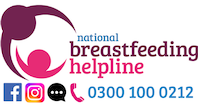The current guidance from the NHS suggests that it is best to wait until your baby is around six months old before introducing foods other than milk. Sometimes parents think that because a younger baby is waking more often, or chewing on their fists, they are ready for solids, but this is not necessarily the case.
There are three signs that a baby is ready for solids:
- The baby can sit up unaided
- The baby can look at the food, use their fingers to pick it up, and bring it to their mouth
- The baby can swallow the food rather than spitting it back out.
When you start to introduce solids, you might choose to spoon-feed pureed food at first, or you might like to try baby-led weaning. Baby-led weaning is when babies are offered bits of food to feed themselves with. Baby-led weaning works well for some babies. It’s ok to try it, to mix it with feeding purees, or to stick to purees to start with.
Vitamins and milk
Until a baby is one year old, the main source of their nutrition is breastmilk (or first-stage formula). Your baby still needs to be given milk after solids are introduced.
Current NHS guidance suggests that all breastfed babies should be given vitamin D from birth until they are six months old, and from six months to five years of age, should be given vitamins A, C and D as a supplement (babies who are given at least 500ml of formula per day do not need this).
You can read more about starting solids here:
https://www.nhs.uk/conditions/baby/weaning-and-feeding/babys-first-solid-foods/

